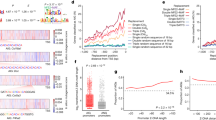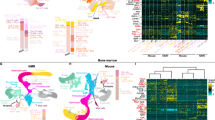Abstract
ZFP36L1 and ZFP36L2 are RNA-binding proteins (RBPs) that interact with AU-rich elements in the 3′ untranslated region of mRNA, which leads to mRNA degradation and translational repression. Here we show that mice that lacked ZFP36L1 and ZFP36L2 during thymopoiesis developed a T cell acute lymphoblastic leukemia (T-ALL) dependent on the oncogenic transcription factor Notch1. Before the onset of T-ALL, thymic development was perturbed, with accumulation of cells that had passed through the β-selection checkpoint without first expressing the T cell antigen receptor β-chain (TCRβ). Notch1 expression was higher in untransformed thymocytes in the absence of ZFP36L1 and ZFP36L2. Both RBPs interacted with evolutionarily conserved AU-rich elements in the 3′ untranslated region of Notch1 and suppressed its expression. Our data establish a role for ZFP36L1 and ZFP36L2 during thymocyte development and in the prevention of malignant transformation.
This is a preview of subscription content, access via your institution
Access options
Subscribe to this journal
Receive 12 print issues and online access
$209.00 per year
only $17.42 per issue
Buy this article
- Purchase on Springer Link
- Instant access to full article PDF
Prices may be subject to local taxes which are calculated during checkout





Similar content being viewed by others
Accession codes
Change history
22 July 2010
In the version of this article initially published, two labels in the key in Figure 1a are reversed. The correct labels are dKO (red line) and Control (blue line). The error has been corrected in the HTML and PDF versions of the article.
References
Georgescu, C. et al. A gene regulatory network armature for T lymphocyte specification. Proc. Natl. Acad. Sci. USA 105, 20100–20105 (2008).
Rothenberg, E.V. Negotiation of the T lineage fate decision by transcription-factor interplay and microenvironmental signals. Immunity 26, 690–702 (2007).
Rothenberg, E.V., Moore, J.E. & Yui, M.A. Launching the T-cell-lineage developmental programme. Nat. Rev. Immunol. 8, 9–21 (2008).
Galante, P.A. et al. A comprehensive in silico expression analysis of RNA binding proteins in normal and tumor tissue: Identification of potential players in tumor formation. RNA Biol. 6, 426–433 (2009).
Taylor, G.A. et al. A pathogenetic role for TNFα in the syndrome of cachexia, arthritis, and autoimmunity resulting from tristetraprolin (TTP) deficiency. Immunity 4, 445–454 (1996).
Carballo, E., Lai, W.S. & Blackshear, P.J. Feedback inhibition of macrophage tumor necrosis factor-α production by tristetraprolin. Science 281, 1001–1005 (1998).
Bell, S.E. et al. The RNA binding protein Zfp36l1 is required for normal vascularisation and post-transcriptionally regulates VEGF expression. Dev. Dyn. 235, 3144–3155 (2006).
Stumpo, D.J. et al. Chorioallantoic fusion defects and embryonic lethality resulting from disruption of Zfp36L1, a gene encoding a CCCH tandem zinc finger protein of the Tristetraprolin family. Mol. Cell. Biol. 24, 6445–6455 (2004).
Stumpo, D.J. et al. Targeted disruption of Zfp36l2, encoding a CCCH tandem zinc finger RNA-binding protein, results in defective hematopoiesis. Blood 114, 2401–2410 (2009).
Blackshear, P.J. et al. Characteristics of the interaction of a synthetic human tristetraprolin tandem zinc finger peptide with AU-rich element-containing RNA substrates. J. Biol. Chem. 278, 19947–19955 (2003).
Hudson, B.P., Martinez-Yamout, M.A., Dyson, H.J. & Wright, P.E. Recognition of the mRNA AU-rich element by the zinc finger domain of TIS11d. Nat. Struct. Mol. Biol. 11, 257–264 (2004).
Emmons, J. et al. Identification of TTP mRNA targets in human dendritic cells reveals TTP as a critical regulator of dendritic cell maturation. RNA 14, 888–902 (2008).
Klein, U. et al. The DLEU2/miR-15a/16–1 cluster controls B cell proliferation and its deletion leads to chronic lymphocytic leukemia. Cancer Cell 17, 28–40 2010).
Mayr, C. & Bartel, D.P. Widespread shortening of 3′UTRs by alternative cleavage and polyadenylation activates oncogenes in cancer cells. Cell 138, 673–684 (2009).
Wiestner, A. et al. Point mutations and genomic deletions in CCND1 create stable truncated cyclin D1 mRNAs that are associated with increased proliferation rate and shorter survival. Blood 109, 4599–4606 (2007).
Sandberg, R., Neilson, J.R., Sarma, A., Sharp, P.A. & Burge, C.B. Proliferating cells express mRNAs with shortened 3′ untranslated regions and fewer microRNA target sites. Science 320, 1643–1647 (2008).
Brennan, S.E. et al. The mRNA-destabilizing protein tristetraprolin is suppressed in many cancers, altering tumorigenic phenotypes and patient prognosis. Cancer Res. 69, 5168–5176 (2009).
Jackson, R.S. II, Cho, Y.J. & Liang, P. TIS11D is a candidate pro-apoptotic p53 target gene. Cell Cycle 5, 2889–2893 (2006).
Baou, M. et al. Involvement of Tis11b, an AU-rich binding protein, in induction of apoptosis by rituximab in B cell chronic lymphocytic leukemia cells. Leukemia 23, 986–989 (2009).
Benjamin, D. & Moroni, C. mRNA stability and cancer: an emerging link? Expert Opin. Biol. Ther. 7, 1515–1529 (2007).
de Boer, J. et al. Transgenic mice with hematopoietic and lymphoid specific expression of Cre. Eur. J. Immunol. 33, 314–325 (2003).
Dumont, C. et al. Rac GTPases play critical roles in early T-cell development. Blood 113, 3990–3998 (2009).
Kelly, A.P. et al. Notch-induced T cell development requires phosphoinositide-dependent kinase 1. EMBO J. 26, 3441–3450 (2007).
Demarest, R.M., Ratti, F. & Capobianco, A.J. It′s T-ALL about Notch. Oncogene 27, 5082–5091 (2008).
O'Neil, J. et al. Activating Notch1 mutations in mouse models of T-ALL. Blood 107, 781–785 (2006).
Wu, Y. et al. Therapeutic antibody targeting of individual Notch receptors. Nature 464, 1052–1057 (2010).
O'Connell, R.M., Rao, D.S., Chaudhuri, A.A. & Baltimore, D. Physiological and pathological roles for microRNAs in the immune system. Nat. Rev. Immunol. 10, 111–122 (2010).
Papadaki, O. et al. Control of thymic T cell maturation, deletion and egress by the RNA-binding protein HuR. J. Immunol. 182, 6779–6788 (2009).
Winandy, S., Wu, L., Wang, J.H. & Georgopoulos, K. Pre-T cell receptor (TCR) and TCR-controlled checkpoints in T cell differentiation are set by Ikaros. J. Exp. Med. 190, 1039–1048 (1999).
Michie, A.M. & Zuniga-Pflucker, J.C. Regulation of thymocyte differentiation: pre-TCR signals and β-selection. Semin. Immunol. 14, 311–323 (2002).
Michie, A.M. et al. Constitutive Notch signalling promotes CD4 CD8 thymocyte differentiation in the absence of the pre-TCR complex, by mimicking pre-TCR signals. Int. Immunol. 19, 1421–1430 (2007).
Campese, A.F. et al. Notch1-dependent lymphomagenesis is assisted by but does not essentially require pre-TCR signaling. Blood 108, 305–310 (2006).
Ciofani, M. & Zuniga-Pflucker, J.C. Notch promotes survival of pre-T cells at the β-selection checkpoint by regulating cellular metabolism. Nat. Immunol. 6, 881–888 (2005).
Pear, W.S. et al. Exclusive development of T cell neoplasms in mice transplanted with bone marrow expressing activated Notch alleles. J. Exp. Med. 183, 2283–2291 (1996).
Aster, J.C., Pear, W.S. & Blacklow, S.C. Notch signaling in leukemia. Annu. Rev. Pathol. 3, 587–613 (2008).
Li, X., Gounari, F., Protopopov, A., Khazaie, K. & von Boehmer, H. Oncogenesis of T-ALL and nonmalignant consequences of overexpressing intracellular NOTCH1. J. Exp. Med. 205, 2851–2861 (2008).
Gonsalves, F.C. & Weisblat, D.A. MAPK regulation of maternal and zygotic Notch transcript stability in early development. Proc. Natl. Acad. Sci. USA 104, 531–536 (2007).
Washburn, T. et al. Notch activity influences the αβ versus γδ T cell lineage decision. Cell 88, 833–843 (1997).
Keene, J.D. RNA regulons: coordination of post-transcriptional events. Nat. Rev. Genet. 8, 533–543 (2007).
Moellering, R.E. et al. Direct inhibition of the NOTCH transcription factor complex. Nature 462, 182–188 (2009).
Schmidlin, M. et al. The ARE-dependent mRNA-destabilizing activity of BRF1 is regulated by protein kinase B. EMBO J. 23, 4760–4769 (2004).
Benjamin, D., Schmidlin, M., Min, L., Gross, B. & Moroni, C. BRF1 protein turnover and mRNA decay activity are regulated by protein kinase B at the same phosphorylation sites. Mol. Cell. Biol. 26, 9497–9507 (2006).
Maitra, S. et al. The AU-rich element mRNA decay-promoting activity of BRF1 is regulated by mitogen-activated protein kinase-activated protein kinase 2. RNA 14, 950–959 (2008).
Palomero, T. et al. Mutational loss of PTEN induces resistance to NOTCH1 inhibition in T-cell leukemia. Nat. Med. 13, 1203–1210 (2007).
Palomero, T., Dominguez, M. & Ferrando, A.A. The role of the PTEN/AKT pathway in NOTCH1-induced leukemia. Cell Cycle 7, 965–970 (2008).
Weng, A.P. et al. Activating mutations of NOTCH1 in human T cell acute lymphoblastic leukemia. Science 306, 269–271 (2004).
Rodriguez, C.I. et al. High-efficiency deleter mice show that FLPe is an alternative to Cre-loxP. Nat. Genet. 25, 139–140 (2000).
Fiorini, E. et al. Dynamic regulation of notch 1 and notch 2 surface expression during T cell development and activation revealed by novel monoclonal antibodies. J. Immunol. 183, 7212–7222 (2009).
Dumortier, A. et al. Notch activation is an early and critical event during T-cell leukemogenesis in Ikaros-deficient mice. Mol. Cell. Biol. 26, 209–220 (2006).
Acknowledgements
We thank A. Clark (Kennedy Institute of Rheumatology, London) for the pcDNA3.myc.WT ZFP36L1 expression construct and pFLAG.CMV2-ZFP36L2; and J. Zuniga-Pflucker (University of Toronto) for OP9-DL1 stromal cells. Supported by Cancer Research UK (D.J.H.), the Addenbrooke's Charitable Trust (D.J.H.), the Medical Research Council (M.T., and a Collaborative Award in Science and Engineering to A.G.), the Biotechnology and Biological Sciences Research Council (BB/C506121/1 to M.T.), the US National Institutes of Health (R01CA120196 and R01CA129382 to A.A.F.), the European College of Obstetrics and Gynaecology tumor bank (U24 CA114737), the Leukemia & Lymphoma Society (A.A.F.), Fonds voor Wetenschappelijk Onderzoek-Vlaanderen (K.D.K.) and the Belgian American Educational Foundation (K.D.K.).
Author information
Authors and Affiliations
Contributions
D.J.H. designed and did experiments, analyzed data and wrote the paper; M.L.J., A.G. and S.E.B. designed and did experiments; C.M.L., R.P., G.G., C.W.S. and H.R.M. developed analytical tools; S.A. designed experiments and analyzed data; K.D.M. and A.A.F. analyzed data; and M.T. designed experiments, analyzed data and wrote the paper.
Corresponding author
Ethics declarations
Competing interests
The authors declare no competing financial interests.
Supplementary information
Supplementary Text and Figures
Supplementary Figures 1–5 and Supplementary Table 1 (PDF 599 kb)
Rights and permissions
About this article
Cite this article
Hodson, D., Janas, M., Galloway, A. et al. Deletion of the RNA-binding proteins ZFP36L1 and ZFP36L2 leads to perturbed thymic development and T lymphoblastic leukemia. Nat Immunol 11, 717–724 (2010). https://doi.org/10.1038/ni.1901
Received:
Accepted:
Published:
Issue Date:
DOI: https://doi.org/10.1038/ni.1901
This article is cited by
-
TREC mediated oncogenesis in human immature T lymphoid malignancies preferentially involves ZFP36L2
Molecular Cancer (2023)
-
The m6A reader IGF2BP3 preserves NOTCH3 mRNA stability to sustain Notch3 signaling and promote tumor metastasis in nasopharyngeal carcinoma
Oncogene (2023)
-
Exploring the genetic landscape of HCV-related B-cell lymphomas using whole exome sequencing
Leukemia (2023)
-
Chromothripsis is a frequent event and underlies typical genetic changes in early T-cell precursor lymphoblastic leukemia in adults
Leukemia (2022)
-
Regulation of neuroendocrine plasticity by the RNA-binding protein ZFP36L1
Nature Communications (2022)



